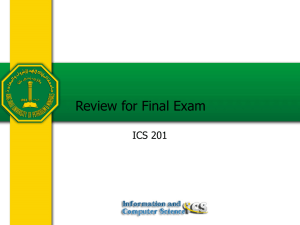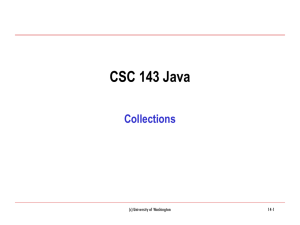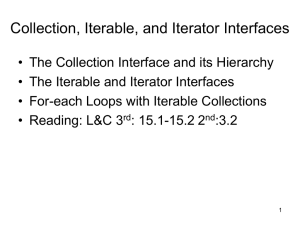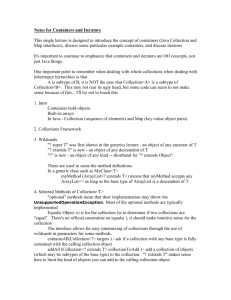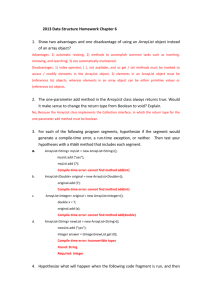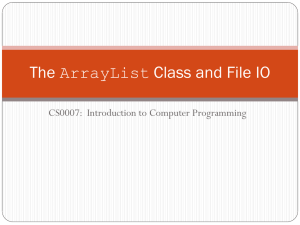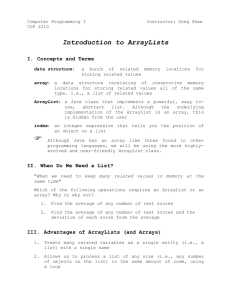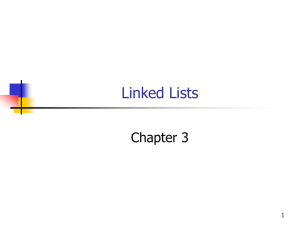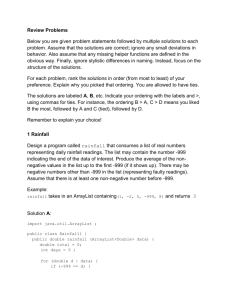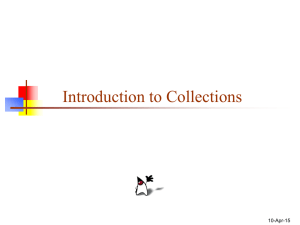Notes
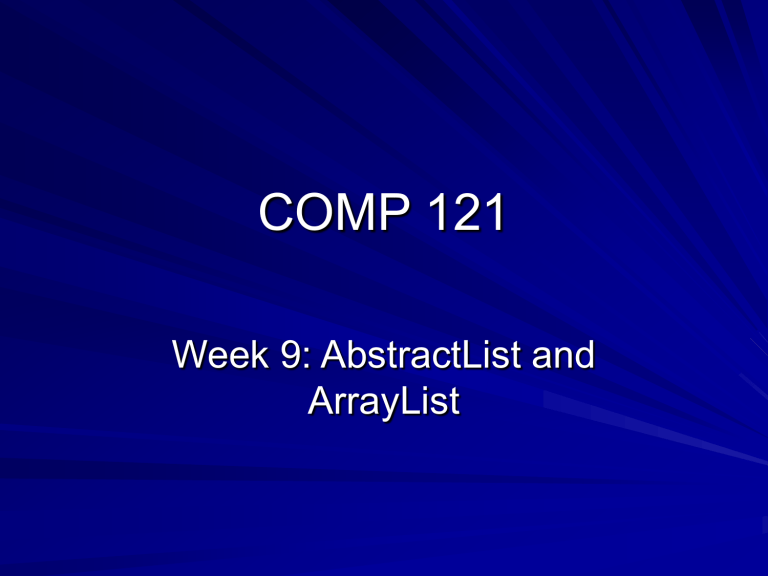
COMP 121
Week 9: AbstractList and
ArrayList
Objectives
List common operations and properties of
Lists as distinct from Collections
Extend the AbstractCollection implementation into AbstractList and
ArrayList implementations and justify design decisions
Analyze the ArrayList implementation to determine algorithmic efficiency
Use ArrayList to solve a problem
List
Interface
A List is an expandable collection of elements in which each element has a position or index
Some lists allow random access
Other lists allow sequential access
Allowed operations on the List interface include:
Finding a specified target
Adding an element to either end
Removing an item from either end
Traversing the list structure without a subscript
Not all classes perform the allowed operations with the same degree of efficiency
List classes provide the ability to store references to
Objects
Our
List
Interface Methods
public interface List<E> extends Collection<E>
{ void add(int index, E element); boolean addAll(int index, Collection<? extends E> coll);
E get (int index); int indexOf(Object obj); int lastIndexOf(Object obj);
ListIterator<E> listIterator();
ListIterator<E> listIterator(int index);
E remove(int index);
E set(int index, E element);
List<E> subList(int fromIndex, int toIndex);
}
List
Class Hierarchy
ArrayList
Simplest class that implements the List interface
Improvement over an array (fixed-size data structure)
Used when a programmer wants to add new elements to the end of a list, but still needs the capability to access the elements stored in the list in arbitrary order
The size of an ArrayList automatically increases as new elements are added
The size method returns the current size
The capacity of an ArrayList is the number of elements an ArrayList can store (grows automatically!)
ArrayList
(cont’d)
The add method can:
Add an element at the end of the ArrayList myList.add(“Bashful”); myList.add(“Awful”); myList.add(“Jumpy”); myList.add(“Happy”);
Add an element at a specific subscript position myList.add(2,”Doc”);
Subsequent calls to the add method will add at the end of the ArrayList myList.add(“Dopey”);
ArrayList
(cont’d)
ArrayList
(cont’d)
The remove method can:
Remove an element at a certain subscript position: myList.remove(1);
You cannot access an ArrayList element directly using a subscript (like with the array), but you can use the get/set methods
String dwarf = myList.get(2); myList.set(2,”Sneezy”);
You can search an ArrayList for an element myList.indexOf(“Sneezy”);
Will return a -1 if the element is not found
ArrayList
(cont’d)
Iterator<E>
Interface
Defined as part of java.util
package
List interface declares the method called iterator , which returns an Iterator object that will iterate over the elements of that list
An Iterator does not refer to or point to a particular node at any given time but points between nodes
Iterator<E> Interface (cont’d)
Iterable
Interface
This interface requires only that a class that implements it provide an iterator() method
The Collection interface extends the
Iterable interface, so all classes that implement the List interface (a subinterface of
Collection ) must provide an iterator() method
The Enhanced
for
Statement
Summary
The List interface defines an expandable collection of elements in which each element has a position or index
Elements in a List can be accessed using an index
The Java API provides the ArrayList<E> class, which uses an array as the underlying structure to implement the List
Summary (cont’d)
An Iterator provides the ability to access the items in a List or Collection sequentially
The Iterator interface defines the methods available to an Iterator
The Iterable interface is extended by the
Collection interface at the root of the Collection hierarchy
The enhanced for statement makes it easy to iterate through a collection (or an array) without explicitly using an Iterator
Questions?
Exam Review – Module 5
Read and write text files
Explain the purpose and use of exception handling for error detection and correction
Differentiate between checked and unchecked exceptions
Use the keywords throws , try , throw , catch , and finally to implement exception handling
Define and use a domain-specific exception hierarchy
Exam Review – Module 6
Read and write binary files
Read and write serialized object files
Distinguish between random and sequential access files
Exam Review – Module 7
Compare and contrast iterative versus sequential software lifecycle approaches
Use CRC cards to capture the responsibilities of each class and the relationships between classes
Use UML class diagrams to illustrate relationships between classes
Use primitive operation counts and deductive reasoning to determine the efficiency of algorithms
Given a set of initial conditions, predict how the runtime of an algorithm is affected by increased input size
Exam Review – Module 8
Describe how generics increase code reuse and type-safety
List the common operations and properties of all collections
Implement the Collection interface in an
AbstractCollection and
ArrayCollection and justify design decisions
Recognize and apply the Iterator design pattern to solve a given problem

